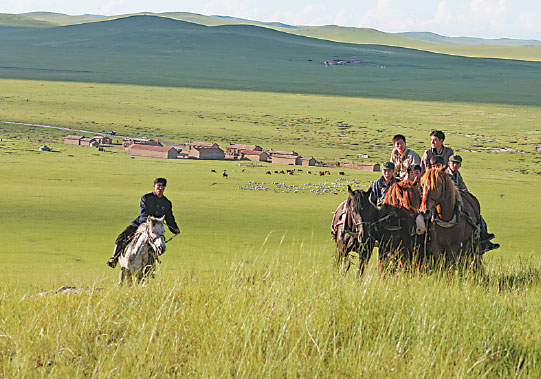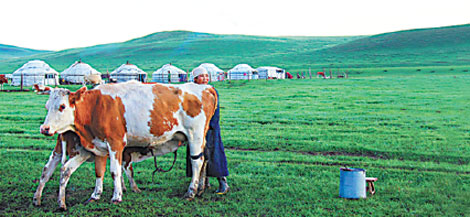Follow nature's allure to the 'edge of the sky'
Hoofing it or on horseback, you'll find the cream of Inner Mongolia's grasslands at Wulagai
Locals call it "the grassland on the edge of sky". Wulagai, in the northeast of Xilin Gol League, is probably the cream of the breathtaking scenery of the Inner Mongolia autonomous region's renowned prairies.
As a dream place for photographers, it also had long caught the eye of French director Jean-Jacques Annaud as he prepared Wolf Totem, the film adaptation of author Jiang Rong's hymn for the grasslands that hit China's big screens earlier this year.
|
The fine scenery of the Wulagai grassland includes Swan Lake. Wulagai is among the best-preserved areas in the Inner Mongolia autonomous region. Photos Provided to China Daily |
|
A film still from French director Jean-Jacques Annaud's Wolf Totem, which hit China's big screens earlier this year. It is an adaptation of author Jiang Rong's hymn for the grasslands. |
|
A woman milks a cow on the Wulagai grassland, which covers more than 5,000 square kilometers but has a population of only about 24,000. |
As one drives from the league's capital, Xilinhot, the landscape spreads out like a green carpet decorated with wildflowers. The road stretches beyond the eyesight and meets the azure sky, which is dotted with fluffy clouds.
It is difficult to find wolves here today, but while stepping on this land, the power of wildness has a tendency to cast off people's memories of urban life. It's easy to seize the moment and commune with nature.
The grassland covers more than 5,000 square kilometers but has a small population, about 24,000. The area is less famous than other grasslands in Inner Mongolia, so it is less crowded in the peak of summer. However, it's among the best-preserved areas in the region.
Joining hiking enthusiasts from all over the country to embark on a trek through Wulagai sounds like a good choice. The route of this event, which is held every June, is more than 210 km, and the hike is scheduled to take seven and a half days. This year's hike will begin on June 29, and for the first time, five additional treks are scheduled through August.
Mornings in Wulagai are slightly cold, even during summer, and unfriendly mosquitoes gather to attack. It is best to be prepared before setting off with long-sleeve shirts to protect yourself from the sunlight, because the day quickly turns sunny and hot, and the boundless grassland immediately becomes brighter.
Herds in the distance look like white spots scattered along the vast green backdrop of mountains. Walking along the zigzagging Wulagai River - the 300 km river is among the longest in Inner Mongolia - the trek seems to be less rocky than it actually is. However, be prepared for a tough journey. You might even wish that the spirit of Genghis Khan will offer you more strength.
If you are not good at sporting activities, you can at least watch others play.
For example, Nadaam, a traditional festival of the Mongolian ethnic group, features archery, horse racing, and bokh (Mongolian wrestling) and will surely be an exciting experience.
After that, don't hesitate to reward your rumbling stomach with a banquet. The hospitable locals will prepare roasted lamb plus fine kumiss, which is made from horse milk in Mongolian yurts. Horood, a kind of dairy tofu, also is a must-try, though its chewy texture might remind you of gum at first bite.
You also might consider a soothing stretch while lying in the grass. Just close your eyes and savor these moments away from all that is annoying.
Contact the writers at wangkaihao@chinadaily.com.cn
If you go
Beijing's Liuliqiao Long-Distance Bus Station offers a direct bus to Wulagai. The ride takes 13 hours, and a one-way ticket costs 380 yuan ($61). There is also flight from Beijing to Xilinhot for about 700 yuan one way, and a bus ride from there to Wulagai takes three and a half hours.
A double room in Wulagai generally costs 150 to 200 yuan, but the price might change in the peak season.
(China Daily 06/22/2015 page7)

















